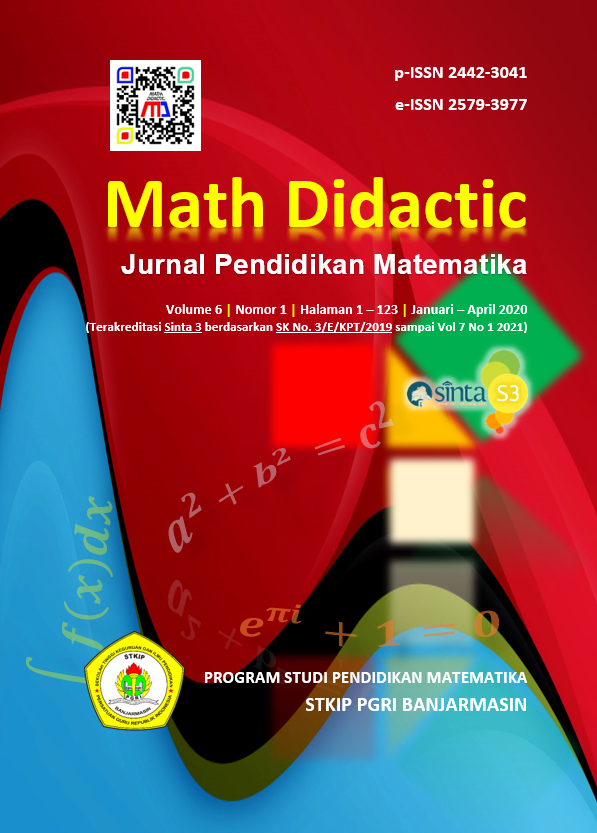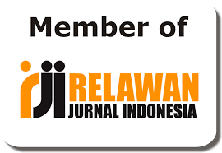Mathematics anxiety maneuver in the process of creative thinking: A review of students in explaining the proving in front of the class
Manuver kecemasan matematika dalam proses berpikir kreatif: Tinjauan pada saat subjek menjelaskan pembuktian di depan kelas
Abstrak
Penelitian kualitatif ini bertujuan mengungkap secara mendalam intervensi kecemasan matematika dalam berpikir kreatif, pada saat subjek menjelaskan soal-soal pembuktian di depan kelas. Subjek penelitian adalah dua orang mahasiswa calon guru matematika, yang satu adalah mahasiswa dengan tingkat kecemasan matematika tinggi (CT) sedangkan yang lain adalah mahasiswa dengan tingkat kecemasan matematika rendah (CR), tetapi kedua subjek mempunyai kemampuan matematika yang setara. Data dianalisis secara kualitatif melalui lima tahapan yaitu penelaahan data, pemeriksaan keabsahan data, reduksi data, penyajian data, dan penarikan kesimpulan. Hasil penelitian ini menunjukkan bahwa kedua subjek bisa menghasilkan cara unik (orisinal) dalam menyelesaikan soal, namun CR lebih lancar, rinci, dan luwes dalam berpikir. Selain itu penelitian ini juga menemukan bahwa CR kurang teliti atau hati-hati dalam berpikir sehingga melakukan kesalahan-kesalahan kecil yang tak disengaja.
##plugins.generic.usageStats.downloads##
Referensi
Aarnos, E., & Perkkilä, P. (2012). Early Signs of Mathematics Anxiety? Procedia - Social and Behavioral Sciences, 46(2003), 1495–1499. https://doi.org/10.1016/j.sbspro.2012.05.328
Abbasi, M., Samadzadeh, M., & Shahbazzadegan, B. (2013). Study of mathematics anxiety in high school students and its relationship with self-esteem and teachers’ personality characteristics. Procedia - Social and Behavioral Sciences, 83, 672–677. https://doi.org/10.1016/j.sbspro.2013.06.127
Ali, M., & Mutawah, A. (2015). The Influence of Mathematics Anxiety in Middle and High School Students Math Achievement. International Education Studies, 8(11), 239-252. https://doi.org/10.5539/ies.v8n11p239
Arslan, C., Deringol-Karatas, Y., Yavuz, G., & Erbay, H. N. (2015). Analysis of Research on Mathematics Anxiety in Selected Journals (2000 – 2013). Procedia - Social and Behavioral Sciences, 177(July 2014), 118–121.
https://doi.org/10.1016/j.sbspro.2015.02.355
Beilock, S. L., & Maloney, E. A. (2015). Math Anxiety: A Factor in Math Achievement Not to Be Ignored. Policy Insights from the Behavioral and Brain Sciences, 2(1), 4–12. https://doi.org/10.1177/2372732215601438
Belbase, S., & Images, S. (2013). Images, Anxieties, and Attitudes toward Mathematics. International Journal of Education in Mathematics, Science and Technology, 1(4), 230-237.
Hoorfar, H., & Taleb, Z. (2015). Correlation Between Mathematics Anxiety with Metacognitive Knowledge. Procedia - Social and Behavioral Sciences, 182, 737–741. https://doi.org/10.1016/j.sbspro.2015.04.822
Kargar, M., Tarmizi, R. A., & Bayat, S. (2010). Relationship between mathematical thinking, mathematics anxiety and mathematics attitudes among university students. Procedia - Social and Behavioral Sciences, 8(5), 537–542. https://doi.org/10.1016/j.sbspro.2010.12.074
Mustafa, S., Melonashi, E., Shkembi, F., Besimi, K., & Fanaj, N. (2015). Anxiety and Self-esteem among University Students: Comparison between Albania and Kosovo. Procedia - Social and Behavioral Sciences, 205(May), 189–194. https://doi.org/10.1016/j.sbspro.2015.09.057
Namkung, J. M. (2019). The Relation Between Mathematics Anxiety and Mathematics Performance Among School-Aged Students: A Meta-Analysis. Review of Educational Research, 20(10), 1-38 https://doi.org/10.3102/0034654319843494
Ndraha, F. (1995). Proses Berpikir Siswa SMP Mengonstruksi Bukti Informal Geometri Sebagai Proses yang Direpresentasikan Secara Visual / Simbolik. Jurnal Math Educator Nusantara, 1(2), 91–105.
Netti, S. (2018). Tahapan Berpikir Mahasiswa dalam Mengonstruksi Bukti Matematis. Matematika Dan Pembelajaran, 6(1), 1. https://doi.org/10.33477/mp.v6i1.437
Núñez-Peña, M. I., Suárez-Pellicioni, M., & Bono, R. (2016). Gender Differences in Test Anxiety and Their Impact on Higher Education Students’ Academic Achievement. Procedia - Social and Behavioral Sciences, 228(June), 154–160. https://doi.org/10.1016/j.sbspro.2016.07.023
Özcan, Z. Ç., & Eren Gümüş, A. (2019). A modeling study to explain mathematical problem-solving performance through metacognition, self-efficacy, motivation, and anxiety. Australian Journal of Education, 63(1), 116–134. https://doi.org/10.1177/0004944119840073
Rector, N. A., Bourdeau, D., Kitchen, K., & Massiah, L. J. (2011). Anxiety Disorders an Information Guide. Canada: Center for Addition and Mental Health.
Rochmad, Agoestanto, A., & Kharis, M. (2018). Characteristic of critical and creative thinking of students of mathematics education study program. Journal of Physics: Conference Series, 983(1). https://doi.org/10.1088/1742-6596/983/1/012076
Wahid, S. N. S., Yusof, Y., & Razak, M. R. (2014). Math Anxiety among Students in Higher Education Level. Procedia - Social and Behavioral Sciences, 123, 232–237. https://doi.org/10.1016/j.sbspro.2014.01.1419
Yaratan, H., & Kasapoğlu, L. (2012). Eighth Grade Students’ Attitude, Anxiety, and Achievement Pertaining to Mathematics Lessons. Procedia - Social and Behavioral Sciences, 46, 162–171. https://doi.org/10.1016/j.sbspro.2012.05.087
Yohanie, D. D., Sujadi, I., & Usodo, B. (2016). Proses Berpikir Mahasiswa Pendidikan Matematika Dalam Pemecahan Masalah Pembuktian Tahun Akademik 2014 / 2015. Jmee, VI(1), 79–90.






















